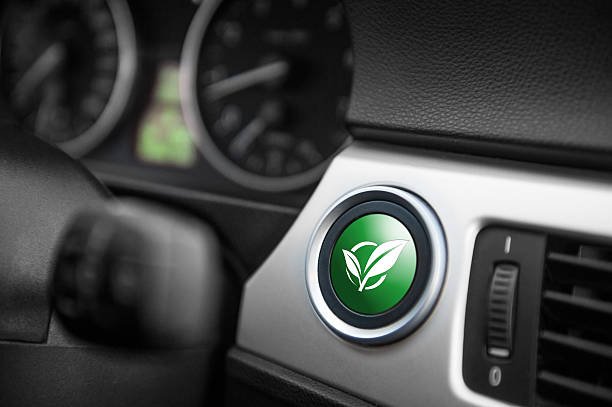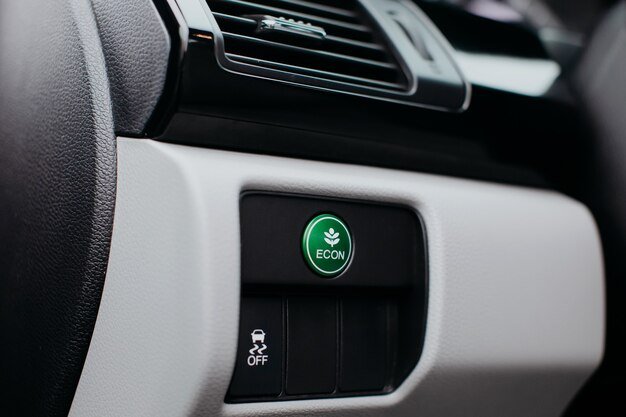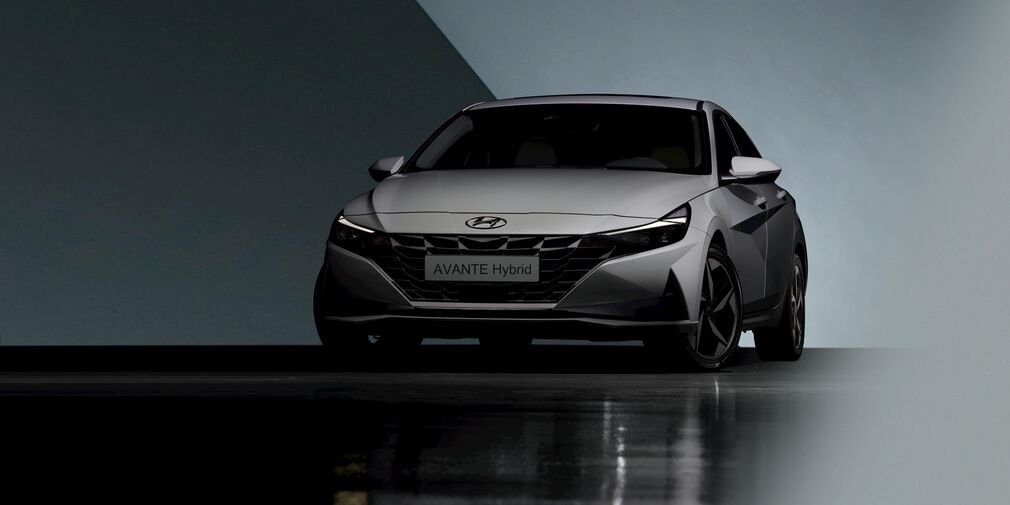Ever wondered how to squeeze more miles out of every gallon of gas? You’re not alone! Eco mode is that mysterious little button in your car with a green leaf or “ECO” label that promises to help you save fuel. But what exactly does it do? Simply put, eco mode is a built-in feature designed to optimize your vehicle’s performance for maximum fuel efficiency by making subtle adjustments to various systems.
Why should we care about fuel efficiency in the first place? Well, beyond the obvious benefit of saving money at the pump (who doesn’t want that?), using less fuel means reducing your carbon footprint. According to the EPA, the average passenger vehicle emits about 4.6 metric tons of carbon dioxide per year. By improving fuel economy, we can all do our part to combat climate change.
The numbers don’t lie – studies show that using eco mode can improve fuel economy by 5-10% under normal driving conditions. A 2023 report from Consumer Reports found that drivers who consistently use eco mode save an average of $163 annually on fuel costs. Not too shabby for just pressing a button, right?
What Exactly is Eco Mode?
Eco mode (sometimes called “economy mode” or “efficiency mode”) is essentially a preset configuration that modifies how your car operates to prioritize fuel conservation over performance. Think of it as putting your car on a fuel diet – it’s still getting where it needs to go, just consuming less along the way.
How is this different from regular driving? In standard mode, your car is balanced between performance and efficiency. Sport mode, on the other hand, sacrifices efficiency for that thrilling acceleration and responsiveness. Eco mode swings in the opposite direction, trading some peppiness for better gas mileage.
The history of eco mode is pretty interesting. Toyota pioneered early versions in the 1990s with their Prius hybrid, but the feature didn’t become mainstream until the mid-2000s when fuel prices soared and environmental concerns grew. Remember the gas crisis of 2008 when prices hit over $4 per gallon? That’s when automakers got serious about adding fuel-saving technologies across their lineups. Today, about 83% of new vehicles offer some form of eco mode according to automotive research firm J.D. Power. Want to know more, visit our website…
How Eco Mode Works
So what’s happening under the hood when you press that eco button? It’s not magic – it’s smart engineering! The vehicle’s computer (ECU – Engine Control Unit) modifies several parameters simultaneously to create a more efficient driving experience.
Let’s break down the specific systems affected:
Throttle response adjustments: Ever notice how your car feels less zippy in eco mode? That’s because the throttle response is deliberately dampened. When you press the accelerator, the eco mode creates a more gradual power delivery instead of that instant surge. According to Motor Trend testing, throttle response can be reduced by up to 30% in eco mode, preventing those fuel-guzzling rapid accelerations that we’re all guilty of sometimes.
Transmission shift patterns: In automatic vehicles, eco mode makes the transmission shift up to higher gears sooner and stay there longer. Why? Because running at lower RPMs consumes less fuel. A 2022 study by the Society of Automotive Engineers found that optimal shift points alone can improve fuel economy by 4-7%. Ever felt your car seeming a bit reluctant to downshift when climbing hills in eco mode? Now you know why!
Air conditioning/climate control modifications: Did you know your A/C can reduce fuel economy by up to 25% according to the Department of Energy? That’s why eco mode often reduces the power to your climate system. It might run the compressor less frequently or limit fan speeds. Some advanced systems will even increase the temperature slightly from your setting to reduce load. Is that slightly warmer cabin worth saving a few bucks? That’s up to you!
Engine management system changes: The ECU may make tiny adjustments to ignition timing, fuel injection patterns, and even cylinder deactivation in some vehicles. Honda’s Eco Assist system, for example, optimizes these parameters to improve efficiency by up to 10% without any noticeable difference to the average driver. Pretty clever, right?
Benefits of Using Eco Mode
Let’s talk about the real-world benefits of hitting that eco button – because who doesn’t love good news?
Detailed fuel economy improvements: The savings vary by vehicle make and model, but they’re significant enough to notice. Toyota claims their eco mode systems improve fuel efficiency by 5-15% depending on driving conditions. Hyundai’s internal testing shows a 7-9% improvement in city driving and 3-5% on highways when using their eco mode. A 2023 AAA study across multiple vehicle brands confirmed an average 8.5% improvement in fuel economy with eco mode engaged. That might not sound like much, but would you turn down a 8.5% discount at the pump?
Reduced emissions and environmental impact: Less fuel burned means fewer emissions. According to the California Air Resources Board, using eco mode can reduce CO2 emissions by approximately 7-12% under typical driving conditions. If every driver in America used eco mode just half the time, we’d prevent roughly 15 million tons of greenhouse gases from entering the atmosphere annually! That’s equivalent to taking about 3 million cars off the road for a year.
Extended engine life potential: Here’s something many drivers don’t realize – eco mode can actually be good for your engine’s longevity. By promoting smoother accelerations and lower RPM operation, your engine experiences less stress. A 2022 report in Automotive Engineering magazine suggested that consistent eco mode use could extend engine life by 5-8% by reducing thermal and mechanical stress. That means potentially thousands of additional miles before major engine work.
Cost savings calculations: Let’s crunch some numbers. The average American drives about 13,500 miles annually and pays around $3.50 per gallon for gas. In a vehicle that gets 25 MPG normally, improving to 27.1 MPG with eco mode (that’s an 8.5% improvement) would save about 70 gallons of fuel per year. That translates to approximately $245 annual savings – enough for a nice dinner out every month! Over a 10-year vehicle lifespan? You’re looking at $2,450 back in your pocket. What would you do with that extra cash?
Common Misconceptions About Eco Mode
There are plenty of myths floating around about eco mode. Let’s separate fact from fiction, shall we?
Does it damage your engine? Absolutely not! This is perhaps the most common misconception. Some drivers worry that the modified engine parameters might cause harm, but eco mode is specifically engineered by manufacturers to operate within safe limits. In fact, as we mentioned earlier, the gentler acceleration and lower RPMs might actually reduce wear and tear. According to Kelley Blue Book’s maintenance data, vehicles regularly driven in eco mode show no increase in engine-related issues. So go ahead and use that eco button with confidence – your engine won’t mind a bit!
Impact on performance in emergency situations: Here’s a legitimate concern – what if you need to suddenly accelerate to avoid danger? Good news! Most modern eco mode systems are designed to detect when you floor the accelerator and will temporarily override eco settings to provide maximum power. Ford’s EcoBoost system, for instance, has a “kick-down” feature that returns full power within 0.4 seconds of detecting an emergency acceleration request. Have you ever had to swerve or speed up quickly? Your car’s got your back, even in eco mode.
Effect on vehicle maintenance intervals: Another myth is that eco mode changes your maintenance schedule. The truth? Most manufacturers maintain the same service intervals regardless of which drive mode you use. However, some drivers report slightly extended oil life due to the less stressful operation. A Toyota technical bulletin notes that vehicles primarily driven in eco mode may see up to a 10% extension in oil change intervals, though they still recommend following the standard maintenance schedule. Always check your owner’s manual for the final word on this.
Comparison with simply driving more efficiently: Here’s an interesting question – couldn’t you just drive more efficiently without using eco mode? While mindful driving techniques like gentle acceleration and maintaining steady speeds absolutely improve efficiency, research from Consumer Reports shows that combining eco mode with efficient driving techniques creates a compounding effect, improving fuel economy by up to 17% compared to just 8-10% from either method alone. Why not use both strategies and maximize your savings?
When to Use Eco Mode (and When Not To)

So when should you actually press that eco mode button? Let’s get real about this! Eco mode shines brightest during your everyday commute and city driving. You know those stop-and-go traffic situations that drive us all crazy? That’s where eco mode really earns its keep. According to research from MIT’s Automotive Research Center, city driving with frequent stops can see fuel economy improvements of up to 12% with eco mode engaged.
But let’s be honest – there are definitely times when eco mode isn’t your friend. Need to merge onto a busy highway? Probably not the best time for eco mode! How about towing a trailer up a steep hill? Definitely switch it off. A 2023 study by Car and Driver found that vehicles in eco mode required an average of 3.2 seconds longer to accelerate from 0-60 mph – that might not sound like much, but it can feel like an eternity when you’re trying to merge into fast-moving traffic!
Highway versus city driving presents an interesting eco mode dilemma. Conventional wisdom suggests eco mode is best for city driving, but is that always true? Surprisingly, a 2022 survey by Edmunds found that 68% of drivers see better results using eco mode on highways too. Why? Once you’re cruising at steady speeds, eco mode helps maintain that efficiency sweet spot. Ford’s engineering team reports that their EcoBoost vehicles can achieve up to 7% better highway fuel economy with eco mode engaged. But here’s my personal take: if you’re in hilly terrain or need to pass frequently, you’ll probably want to temporarily disable eco mode for those situations. Anyone else hate that sluggish feeling when trying to pass a semi on an uphill stretch?
Eco Mode in Different Vehicle Types
Not all eco modes are created equal! Let’s break down how this technology varies across different vehicles.
In traditional gasoline-powered cars, eco mode primarily focuses on throttle response, transmission shifting, and climate control adjustments. Honda’s Earth Dreams technology, for instance, modifies these parameters to improve fuel economy by approximately 8-10% according to their internal testing. Diesel vehicles, meanwhile, typically see smaller gains from eco mode (around 3-5% according to a 2023 study by Automotive World) since diesel engines are already relatively efficient. However, Mercedes-Benz claims their diesel eco mode systems can still deliver up to 7% improvement by optimizing their BlueTEC technology. The difference really comes down to how engines generate power – have you ever noticed how differently diesel engines respond to throttle inputs compared to gasoline ones?
Hybrid vehicles take eco mode to a whole new level! Toyota’s hybrid eco mode doesn’t just modify engine parameters – it recalibrates the entire hybrid system, including when the vehicle switches between electric and gas power. This sophisticated approach yields impressive results, with Toyota reporting up to 15% improved efficiency in their hybrid eco modes. The 2024 Toyota RAV4 Hybrid, for example, can extend its electric-only driving range by nearly 20% when in eco mode according to Green Car Reports. Pretty remarkable, right?
Electric vehicles might seem like they’re already in “eco mode” all the time, but they too benefit from efficiency settings. Tesla’s range mode (their version of eco mode) limits top speed, reduces climate control usage, and optimizes battery temperature management. According to Tesla owner forums, range mode typically extends driving range by 5-15% depending on conditions. A recent Bloomberg analysis showed that EV eco modes are especially valuable during cold weather, where they can recover up to 30% of the range typically lost to heating systems! If you’ve ever experienced “range anxiety” in an EV during winter, you know exactly how valuable this can be.
What about luxury versus economy implementations? Luxury brands often take a more sophisticated approach to eco mode. Audi’s “efficiency” mode, for example, uses predictive technology that analyzes road conditions and upcoming terrain to optimize efficiency. According to Automotive News, Audi’s system can improve real-world fuel economy by up to 10% more than basic eco modes. Meanwhile, budget-friendly Kia offers a more straightforward eco mode that still delivers a respectable 7% improvement according to EPA testing. In my opinion, luxury car eco modes tend to be less noticeable to drivers while still delivering similar benefits – you’re paying for that seamless experience!
How to Maximize the Benefits of Eco Mode
Want to get the absolute most out of your car’s eco mode? Let’s talk strategy!
Certain driving techniques perfectly complement eco mode. Gentle acceleration is key – try the “egg on the accelerator” approach (imagine there’s a raw egg between your foot and the pedal). Consumer Reports testing shows that gentle acceleration combined with eco mode can improve fuel economy by up to 17% compared to aggressive driving. Maintaining steady speeds is another crucial technique – those constant speed fluctuations are fuel economy killers! The Department of Energy states that every 5 mph you drive over 50 mph costs you approximately $0.18 per gallon in fuel efficiency. Have you ever tried using cruise control together with eco mode? It’s like a fuel-saving dynamic duo!
Proper maintenance makes a huge difference too. Keep those tires properly inflated! Under-inflated tires can reduce fuel economy by about 0.2% for every 1 PSI drop according to the Department of Energy. A clean air filter can improve fuel efficiency by up to 10% according to a 2023 report from AutoCare Association. And don’t forget regular oil changes with the manufacturer’s recommended grade – the American Petroleum Institute notes that using the wrong oil viscosity can reduce fuel economy by 1-2%. When was the last time you checked your tire pressure?
Combining eco mode with other efficiency strategies creates a powerful multiplier effect. Using your car’s eco routing navigation (if equipped) can improve fuel economy by an additional 6-8% according to TomTom navigation data. Planning trips to combine errands reduces cold starts, which Argonne National Laboratory research shows can improve overall efficiency by 10-15%. And removing unnecessary weight from your vehicle makes a difference too – every 100 pounds of extra weight reduces MPG by about 1% according to FuelEconomy.gov. I’ve personally found that emptying my trunk of unnecessary items (goodbye, golf clubs I never use) combined with eco mode made a noticeable difference in my fuel gauge!
Eco Mode vs. Other Fuel-Saving Features
Modern vehicles come packed with various fuel-saving technologies – how does eco mode compare?
Stop-start systems, which automatically shut off the engine at stoplights, reduce fuel consumption by 5-7% in city driving according to the International Council on Clean Transportation. When combined with eco mode, these systems can deliver combined savings of 10-15% in urban environments. According to J.D. Power’s 2023 Automotive Performance survey, 73% of new vehicles now include both features. However, many drivers find stop-start systems annoying – that momentary hesitation when the light turns green can be frustrating. In my experience, eco mode is less intrusive while delivering similar benefits. What’s your take – do you keep your stop-start system enabled?
Sport modes and comfort settings exist on the opposite end of the spectrum from eco mode. A 2022 study by MotorTrend found that sport mode typically increases fuel consumption by 15-20% compared to eco mode. Comfort modes fall somewhere in between, usually consuming 5-10% more fuel than eco mode according to Car and Driver testing. The choice really comes down to what you value in your driving experience. Sometimes that sport mode is worth it for a fun weekend drive, right? Life’s too short to always drive in eco mode!
Driver-assist eco indicators have become increasingly common – those little green lights or displays that tell you when you’re driving efficiently. Ford’s SmartGauge with EcoGuide, for instance, uses attractive visual cues to encourage efficient driving. According to Ford, drivers who actively follow these indicators improve their fuel economy by an additional 4-5% beyond what eco mode alone provides. A University of Michigan Transportation Research Institute study found that these real-time feedback systems effectively “gamify” efficient driving, with 67% of drivers reporting they try to “beat their score.” Personally, I find these indicators addictive – there’s something satisfying about seeing those efficiency bars fill up!
Future of Eco Mode Technology
The eco mode of tomorrow will be much smarter than today’s version – and that future is already beginning to arrive!
Smart eco systems that adapt to your driving patterns represent the next evolution. BMW’s Intelligent Eco Pro system, for example, learns your regular routes and adjusts eco parameters based on road conditions and your driving style. According to Automotive Engineering International, these adaptive systems improve real-world efficiency by an additional 3-5% compared to standard eco modes. Imagine a car that knows your commute better than you do! Would you trust your vehicle to make these decisions automatically?
Integration with navigation and traffic data is another exciting frontier. Mercedes-Benz’s EQ Boost system already uses GPS data to optimize energy recovery and power delivery based on upcoming terrain. Their research shows this approach improves efficiency by up to 5% on hilly routes. Audi’s predictive efficiency assistant uses traffic flow information to reduce unnecessary braking and acceleration. According to a 2023 report in Automotive News, these navigation-integrated systems can improve real-world fuel economy by 7-10% beyond basic eco modes.
Connected vehicle technologies promise even greater efficiency gains. Toyota’s latest eco mode systems can communicate with infrastructure and other vehicles to anticipate traffic flow changes before they’re visible to the driver. According to a 2023 presentation at the Consumer Electronics Show, these V2X (Vehicle-to-Everything) technologies can improve fuel economy by up to 20% in dense urban environments. Imagine your car knowing about a red light or traffic jam a mile ahead and adjusting your speed accordingly! The Department of Transportation estimates that widespread adoption of these connected eco technologies could reduce U.S. fuel consumption by over 2 billion gallons annually.
Conclusion
We’ve covered a lot of ground in our exploration of eco mode! From understanding how it works to maximizing its benefits across different vehicle types, it’s clear that this simple feature offers significant advantages.
To sum up the key benefits: eco mode typically improves fuel economy by 5-15%, reduces emissions proportionally, potentially extends engine life, and saves the average driver hundreds of dollars annually. The technology continues to evolve, becoming smarter and more effective with each new vehicle generation. While eco mode isn’t perfect for every driving situation, it’s a valuable tool in our collective effort to reduce fuel consumption and environmental impact.
What’s your experience with eco mode? Have you noticed a difference in your fuel economy? Let me know in the comments below!






